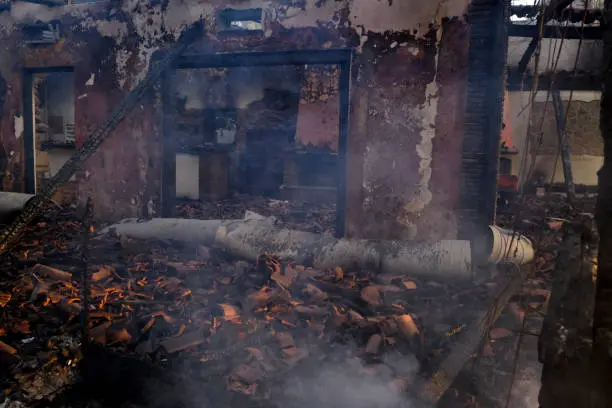Indoor air quality is crucial for maintaining a healthy living environment, and one of the often-overlooked contributors to poor air quality is smoke residue. Whether it comes from tobacco, cooking, or burning wood, smoke can significantly impact our health and well-being. Understanding how smoke residue affects indoor air quality is essential for creating a healthier home. This blog aims to shed light on the various aspects of smoke residue and its implications for indoor air quality.
Understanding Smoke Residue

Smoke residue comprises particulate matter, gases, and volatile organic compounds (VOCs) released into the air during combustion. When materials burn, they produce a complex mixture of components that can linger in indoor environments. Common sources of smoke include cigarettes, fireplaces, candles, and cooking activities. The size of the particulate matter is essential, as smaller particles can penetrate deep into the lungs and bloodstream, posing severe health risks. This residue can settle on surfaces, become embedded in fabrics, and remain airborne for extended periods. These particles can also react with other indoor air pollutants, further complicating the air quality.
Additionally, smoke residue emits an unpleasant odor that is difficult to eliminate, making it a significant concern for many households. To effectively address these challenges, specialized services like Cleanup & Total Restoration smoke odor control can be invaluable, offering tailored solutions to neutralize odors and remove harmful residues, ensuring a healthier indoor environment.
Health Risks Associated with Smoke Residue
The presence of smoke residue can lead to numerous health issues. Research has shown that exposure to indoor smoke, especially from tobacco, can cause respiratory diseases, cardiovascular problems, and even cancer. For non-smokers, particularly children and pregnant women, the risks are even more pronounced. Secondhand smoke can lead to developmental issues in children, as well as lower birth weights and a higher likelihood of sudden infant death syndrome (SIDS).
Moreover, smoke residue can exacerbate existing health conditions such as asthma and allergies. Exposure to particulate matter can trigger attacks in asthma patients and lead to increased frequency and severity of allergic reactions. Individuals with compromised immune systems may also find themselves more susceptible to respiratory infections and other complications due to the detrimental effects of smoke in the air.
Sources of Smoke Residue Inside the Home
Tobacco smoke is perhaps the most well-known source of indoor smoke residue, but it is not the only contributor. Cooking activities, especially frying and grilling, can release smoke that contains harmful particles and VOCs. Using fireplaces, wood stoves, and candles also generates smoke that can linger long after the flames are extinguished. Even incense and scented oils can contribute to indoor air pollution if used excessively.
The accumulation of smoke residue is also influenced by ventilation practices within a home. Poorly ventilated areas allow smoke particles to linger longer, increasing the risk of health issues. Understanding these sources is vital for identifying potential risks and taking corrective measures to improve indoor air quality.
The Role of Ventilation in Mitigating Smoke Residue
Effective ventilation is critical in minimizing the impact of smoke residue on indoor air quality. Proper airflow can help dilute smoke particles and VOCs, allowing them to exit the space rather than accumulate. Natural ventilation, such as opening windows and doors, can significantly reduce indoor smoke concentrations, especially during cooking or after smoking indoors.
Mechanical ventilation systems, like exhaust fans and air purifiers, can also play a vital role in improving indoor air quality. High-efficiency particulate air (HEPA) filters are particularly effective at capturing small particles and can be integrated into heating, ventilation, and air conditioning (HVAC) systems. Regular maintenance of these systems ensures that they function optimally and continue to provide clean, fresh air.
Effective Cleaning and Remediation Strategies
Removing smoke residue from indoor environments can be a challenging task, especially when restoring properties after fire damage. Regular cleaning is essential to reduce the buildup of smoke particles on surfaces, as these can negatively impact air quality and the overall environment. Dusting with a damp cloth can help prevent particles from becoming airborne, while more intensive cleaning methods, such as specialized smoke cleaning solutions, are often necessary for heavily affected areas. In cases where smoke damage is extensive, professional cleaning services specializing in smoke remediation can be invaluable. These experts use advanced equipment and techniques to thoroughly remove residue from walls, ceilings, carpets, and other surfaces, effectively restoring the indoor space to a healthier and more livable condition.
Impact on Indoor Odors
In addition to health risks, smoke residue can significantly impact indoor odors. The lingering smell of smoke can be unpleasant and often requires extensive efforts to eliminate it. Smoke particles can absorb into fabrics, carpets, and furniture, making removal challenging. This not only creates an uncomfortable atmosphere but can also affect the overall perception of cleanliness in the home.
The use of air fresheners or scent neutralizers can mask smoke odors temporarily but does not address the root cause. Long-term solutions involve thorough cleaning and reducing smoke exposure in the first place. Natural solutions, such as using baking soda or activated charcoal, can help absorb odors, although they may not completely eliminate smoke particles.
Conclusion
Smoke residue is a significant contributor to poor indoor air quality, posing various health risks and creating unpleasant environments. Understanding the sources and impacts of smoke residue is crucial for implementing effective mitigation and remediation strategies. Ensuring proper ventilation, regular cleaning, and addressing smoking habits are vital steps in promoting better indoor air quality.
By taking proactive measures, we can reduce the harmful effects of smoke residue and create a healthier, more pleasant living space. Awareness and action are key to improving indoor air quality and safeguarding the health of everyone in the household. In an era where indoor air quality is increasingly emphasized, addressing smoke residue is an essential part of maintaining a healthy home environment.